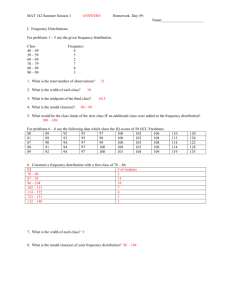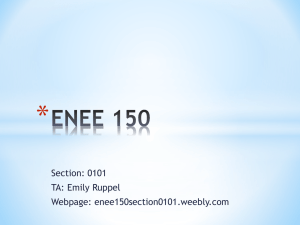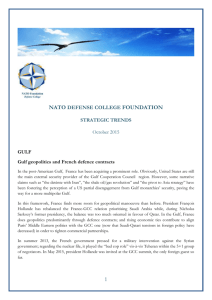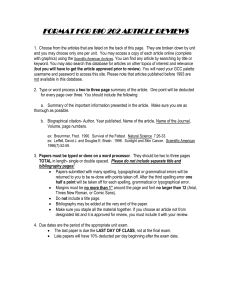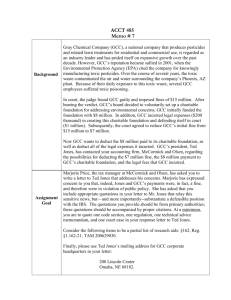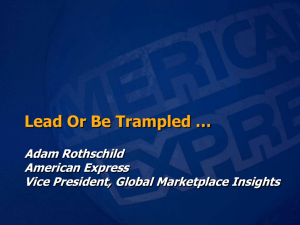Evaluation of Gulf Cooperation Council
advertisement
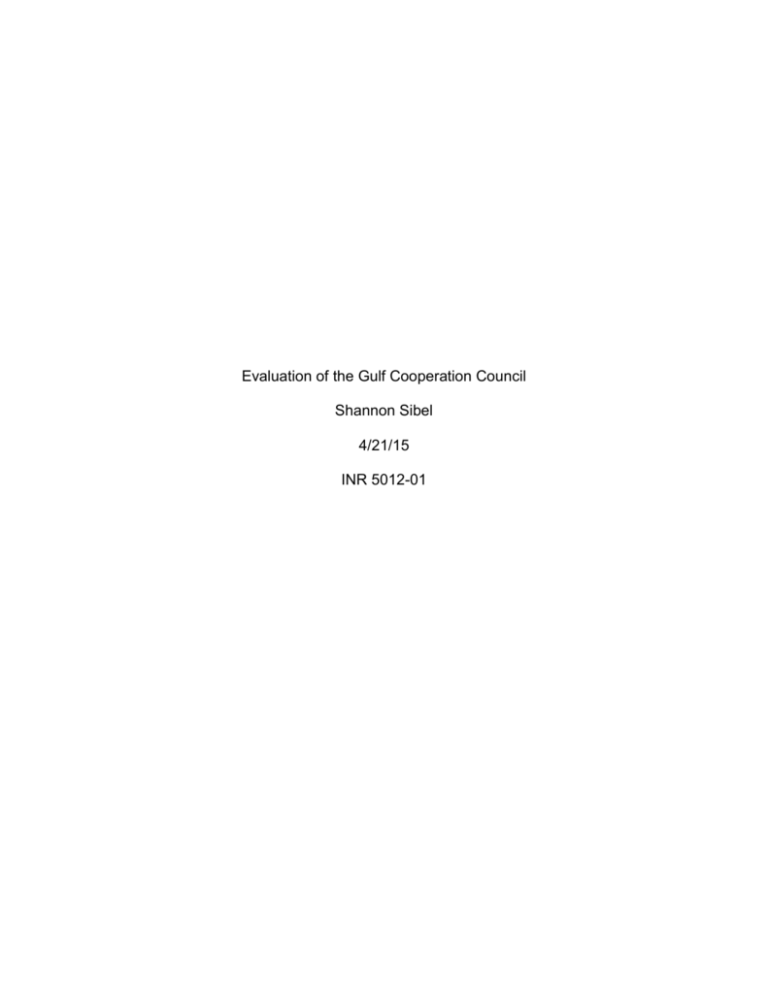
Evaluation of the Gulf Cooperation Council Shannon Sibel 4/21/15 INR 5012-01 Sibel 1 Regional organizations are intergovernmental organizations created through regionalism. They are often formed as a result of shared identities and ideologies, a shared sense of threats, and economic interdependence (Karns & Mingst, 2010, p. 145152). The three main schools of thought in international relations (realism, liberalism, and constructivism) each view the roles of IGOs and regional organizations in international politics differently. Realism is based on the assumption that individuals act rationally to protect their own interests. States are primary actors and they coexist in an anarchic international system. For realists, international law and government are, for the most part, weak and ineffective. International organizations are tools for states to use when it suits them and they are no more than the sum of their member states. International organizations have no independent effect on state behavior and will not change the system itself (Karns & Mingst, 2010, p. 45-50). Liberalism is based on the ideas that human nature is basically good and human behavior can be changed and perfected through collective action and institutional reform. Liberals also believe that cooperation between actors is possible and will grow over time. They see international organizations as playing positive roles in facilitating cooperation (Karns & Mingst, 2010, p. 35-45). Constructivism is concerned with the identities and interests of actors and how these can change. Constructivists believe that behavior is shaped by these identities and interests. They place a lot of importance on institutions. In regards to international organizations, constructivists believe that they have great power and that they “construct the social world in which cooperation and choice take place” (Karns & Mingst, 2010, p. 50-51). International organizations have independent effects on international relations and have been important in the processes Sibel 2 of changing understandings and behaviors with various international problems (Karns & Mingst, 2010, p.52). The Gulf Cooperation Council is a political and economic alliance located in the Persian Gulf. It was established in 1981 (“GCC: History”, 2015). The organization was created as a reaction to various economic and security threats occurring in the region at the time. These threats include the Iranian Revolution and the Iran-Iraq War (“Profile: Gulf Co-operation Council”, 2012). With an absence of a comparable organization, the GCC was created as a practical solution to these economic and security concerns in the region (Anthony, 1986, p. 41-42). The original members of the GCC include the United Arab Emirates, Bahrain, Saudi Arabia, Oman, Qatar, and Kuwait. 1 These countries share similar political systems and a common cultural outlook (“Profile: Gulf Co-operation Council, 2012). Membership of the GCC has not changed but there have been talks about admitting Yemen as a member. There are plans to have Yemen join by 2016 but there are some challenges to its inclusion, including objections from Kuwait and Yemen’s economic and security problems (Sharp, 2014). The original objectives of the Gulf Cooperation Council are laid out in the organization’s charter. Some of their objectives are very broad, including “achieving cooperation among the member states” and “strengthening the links of cooperation among the peoples of the member states in different fields” (Nakhleh, 1986, p. 8). Other objectives are more specific, such as cooperation and establishing similar systems in fields including economics, trade, and commerce; education and culture; and social 1 For a map of the GCC countries, see Appendix. Sibel 3 welfare and health. Stimulating scientific and technological progress is the final objective listed in the GCC charter. Security is not listed as one of the objectives in the GCC charter. However, it has been a major focus of the organization since its creation (Nakhleh, 1986, p. 8). The structure of the GCC has remained the same since the organization’s creation. It consists of the Supreme Council, the Commission for Settlement of Disputes, the Ministerial Council, and the Secretariat General. The Supreme Council consists of the heads of state and is responsible for determining major political and economic decisions. It is the only body of the organization that can hand down binding decisions. Two-thirds of the member states must be present to vote on resolutions. Unanimous decisions are required for approval on substantive matters. A majority vote is required for all procedural issues (Peterson, 1988, p. 107-110). The Commission for Settlement Dispute is attached to the Supreme Council and its function is to provide recommendations to the Supreme Council in cases of disagreement or disputes between member states (Peterson, 1988, p. 109). The function of the Ministerial Council is to develop and propose to the Supreme Council various means to promote further cooperation between member countries. The voting procedures of the Ministerial Council are the same as the Supreme Council (Peterson, 1988, p. 109). The Secretariat General carries out the day-to-day functions of the organization (Nakhleh, 1986, p. 11). The Gulf Cooperation Council has had most of its success when dealing with economic and security issues but it has had little success in achieving its other objectives. This can be explained by the realists’ perspective that international Sibel 4 organizations are tools for the member states to use for their benefit when it suits them. The states clearly view economic and security issues as their main concerns and it is evident in the policy making if the GCC. This paper will show this by focusing on specific programs and initiatives related to each objective and determining the success of each program, as well as showing the variety of programs related to each objective. The success of the programs will be determined by whether or not they achieved what they were set up to achieve. Although security is not an official objective listed in the GCC charter, it will be considered an objective of the organization for the purposes of this paper because it has been a major focus of the organization since its creation. Economics Economic issues are a major concern for the GCC countries. One of the organization’s first courses of action after its creation was the signing of the Unified Economic Agreement by each of the member states (“GCC: History”, 2015). Economic issues that the Gulf Cooperation Council has dealt with include its reliance on oil, the GCC common market, the GCC monetary union, the adoption of a single currency, and the GCC customs union. Role of Oil in GCC Member States The oil reserves of the GCC member countries account for 43 percent of the world’s oil reserves (Story, 1988, p. 112). The economies of the GCC are very dependent on their oil revenues, as they are the single most important source of income and foreign exchange for these countries (Ramazani, 1988, p. 96). Early on in the Sibel 5 GCC’s existence, the leadership of the organization recognized the need to reduce their countries’ reliance on oil. However, policies were still created to expand GCC activities in international oil operations. This can been seen in a resolution, passed during the organization’s first summit meeting, that calls for “joint cooperation for the establishment of an integrated oil industry including exploration, refining, marketing, industrialization, pricing, transport, utilization of gas and development of energy sources” (Anthony, 1986, p. 392). Development of non-oil industries began in 1982 with the creation of the Gulf Investment Corporation. The early plans for the GIC were to invest in petrochemical, industrial, and livestock projects (Ramazani, 1988, p. 100). By 1986, there were five main projects underway, most of which were related to aluminum. It was believed that the GIC could be an effective vehicle for economic diversification in the GCC (Peterson, 1988, p. 152). However, this has not been the case. Although the GIC has been making profits and the economies of the Gulf Cooperation Council member states have been growing rapidly, there is still a reliance on oil exports. The productivity of the organization overall fell between the years 2000 and 2007 when the oil and gas sector is excluded. When comparing the smaller diversified economies with the more resource dependent ones, the diversified economies performed better in the selected years (Sarieddine, 2008). The GCC member states have been fairly successful in integrating their oil industries but overall they have failed to expand their economies beyond the oil industry. This lack of diversification will hurt these countries in the long run because of falling oil prices and the finite amount of oil reserves available (Gally, 2015). Sibel 6 GCC Common Market The Gulf Cooperation Council has been trying to create a common market since the creation of the organization. Shortly after the creation of the GCC, a free-trade area was established between the member states. Since the goods of the member countries are essentially competitive and not complementary, this was more of a symbolic achievement than a functional achievement. Although it was not very advantageous immediately, the free-trade area was seen as something that could be advantageous in the futures once the member countries diversified their economies (Ramazani, 1988, p. 102). The GCC common market was finally created in 2008. The goal of the GCC common market is to “remove all barriers to cross country investments and services trade by granting national treatment to all GCC firms and citizens in any other GCC country” (“GCC: History, 2015). Along with equal economic opportunities, such as setting up companies, and buying and selling properties, the common market also permits equal rights of citizens in all six countries in areas such as education, healthcare, and employment (Bowman, 2008). Although the GCC common market was created in 2008, the implementation is not yet complete. This is due to competing national interests and a lack of bureaucratic capacity. This has lead to a delay in enactments of “various national statutes necessary to allow the truly uninhibited movement of goods, services, capital, and labor (Takagi, 2012, p. 17). Even with this delay in necessary enactments, there has still been an increase in inter-GCC trade activities that can, at least in part, be attributed to the Sibel 7 implementation of the GCC common market. With a properly functioning common market, the results could be even better (Ali, 2014). GCC Monetary Union and Single Currency Following the implementation of the GCC common market in 2008, the organization set a goal to create a monetary union and a common currency by 2010 (Bowman, 2008). The deadline that the GCC had set for the creation of a monetary union was originally 2005 and the original deadline for a common currency was 2010 (“Gulf States Push for Single Currency”, 2002). The change in the deadline is largely attributed to the delay in implementing the customs union, which is believed to be necessary to have in order to create the monetary union (Dash, 2015). The Monetary Union Agreement was finally signed in June 2009 along with the Basic Statute of the Monetary Council. The Monetary Council was intended to be a precursor to a GCC central bank. The agreement “calls for the development of the requisite financial infrastructure, including payment and settlement systems, statistical systems, and the adoption of uniform banking regulation and supervisory rules” (Takagi, 2012, p. 13). The role of the Monetary Council is to prepare this infrastructure, develop rules and policies, and recommend legislation for the establishment of a central bank and the introduction of bank notes and coins (Takagi, 2012, p. 13). The creation of a unified currency has been a goal of the Gulf Cooperation Council since the signing of the Unified Economic Agreement in 1982. By creating a common currency, the GCC member states will no longer have to worry about bilateral exchange rates. This will increase the efficiency of GCC economies and broaden their Sibel 8 degree of economic integration (Jadresic, 2002, p. 6). A common currency has not yet been created but the idea has not been abandoned. In 2007 the GCC member countries agreed on five convergence criteria. These criteria include limits on inflation, limits on interest rates, the amount of foreign reserves needed, limits on public debtGDP ratio, and limits to the public budget deficit-GDP ratio (Takagi, 2012, p. 12-13). One of the challenges to the creation of a monetary union and a common currency is the issue of sovereignty. Each country will have to give up the possibility of unilaterally changing the value of the currency they use (Jadresic, 2002, p. 11). The likelihood of a common currency being adopted has been lowering as more members pull out of negotiations (Wigglesworth, 2009). Oman opted out of the union in 2006. Then the United Arab Emirates dropped the plans to join the union in response to the GCC’s decision to locate the Monetary Council in Saudi Arabia (Khan, 2014). The common market was supposed to pave the way for a monetary union but, as mentioned earlier, there have been delays in the implementation of the GCC common market (Takagi, 2012, p. 12). GCC Customs Union As stated earlier, the GCC created a free trade area between the member states shortly after the establishment of the organization (Ramazani, 1988, p. 102). A customs union was created in 2003 but very little progress had been made up until recently (“Profile: Gulf Co-operation Council”, 2012). This was due mainly to differences on the distribution in tax revenue and barriers facing local exporters at border customs points in the region (“GCC: History”, 2012). The purpose of the customs union is to create a Sibel 9 territory where customs duties and regulations restricting trade among member states is abolished. Uniform customs duties and regulations for trade with non-member states are also implemented. Customs are inspected and customs duties are paid at the first point of entry to the union (Gulf Cooperation Council, 2003). Tariff and non-tariff barriers to trade between member states are eliminated. Goods produced in any member state are given the same treatment as national products (GCC, 2001). Up until 2015 there was only a partial implementation of the customs union. During this time, trade between GCC member states increased significantly. However, intra-GCC trade has only grown to about 10 percent of GDP during partial implementation. This is very small compared to intra-EU trade accounting for 60 percent of the EU’s GDP and intra-Asean trade accounting for 25 percent during the same time period (Al Asoomi, 2014). The GCC customs union became fully operational in January 2015. Intra-GCC trade is expected to continue to increase (GCC Customs Union Fully Operational, 2015). The customs union will facilitate the smooth movement of goods and investments, which can contribute to commodity diversification. This makes the customs union essential to the GCC’s efforts to diversify sources of income and reduce their dependence on oil revenues. It will inevitably lead to accelerated growth in non-oil sectors in the GCC economies (Al Asoomi, 2014). Security Although collective security of the region is not an official objective listed in the Gulf Cooperation Council’s charter, security is a major concern for the organization. The Sibel 10 GCC was established in a time with great regional security threats and was created as a reaction to these threats. These threats include the Iran-Iraq War, the Iranian Revolution, the Soviet invasion of Afghanistan, and the Arab-Israeli Conflict (Peterson, 1988, p. 179). The GCC has taken steps to ensure the security of the Persian Gulf region. These steps include the Internal Security Agreement, the Comprehensive Security Strategy, the Peninsula Shield Force and Joint Defense Agreement, and the Unified Military Command. Internal Security Agreement The Internal Security Agreement consists of legal articles that deal with matters of security cooperation among the GCC member states (GCC, 2012). The Security Agreement was first proposed in 1982. Because of Kuwaiti objections to the language of the treaty, the GCC failed to ratify the agreement (Gold, 1986, p. 392). The agreement was amended in 1994 but Kuwait was still opposed to various amendments. The latest amended version was introduced in 2012. This was finally the version that was approved by the GCC leaders (Kechichian, 2014). The initial Security Agreement and the subsequent amended versions were responses to security concerns in the region. These concerns include the seizure of the Grand Mosque in Mecca in 1980, a failed coup attempt in Bahrain in 1981, the Iran-Iraq War, and the invasion of Kuwait in 1991 (Kechichian, 2014). The articles of the Security Agreement prior to the 2012 version require member states to “cooperate with each other to hunt down those who are outside law or the system, or who are wanted by states, whatever their nationality, and to take necessary action against them.” (al-Saadi, Sibel 11 2014). It also allows for states to take legal action against citizens of any of the member states in regards to crime. It also requires states to share personal information of citizens with other member states. It allows security forces to enter into the territory of another member state during pursuits of wanted individuals and requires the immediate extradition of wanted individuals. It was language like this that the leaders of Kuwait objected to because it goes against their constitution (al-Saadi, 2014). The leaders of Kuwait finally approved the 2012 version because it did not include language that contradicted the Kuwaiti constitution. However, even with the removal of this language, there were still members of the Kuwaiti parliament who believed that the agreement threatened the sovereignty of the state (Kechichian, 2014). Comprehensive Security Strategy The GCC Comprehensive Security Strategy was adopted in 1987. The strategy is a general framework for security cooperation among member states (GCC, 2012). It consists of cooperation in multiple aspects of defense and security (Christman & Moore, 2015, p. 5). It outlines the general objectives as well as the tools of implementation of the strategy (GCC, 2012). The strategy focuses on illicit trafficking, immigration, airport security, drug fighting, weapons, border guards, and civil defense (Christman & Moore, 2015, p. 5). Because this agreement also had language in regards to extraditions and hot pursuits that contradict Kuwait’s constitution, there was an initial difficulty in the ratification of this document, just as there was a difficulty with the Internal Security Agreement. However, the Comprehensive Security Strategy was much more quickly Sibel 12 amended than the Internal Security Agreement and was approved in much less time (Peterson, 1988, p. 208). Peninsula Shield Force and the Unified Military Command In 1984, the GCC created a collective security force called the Peninsula Shield Force (“Profile: The Gulf Co-operation Council”, 2012). It currently consists of a Saudi brigade and a composite brigade made up of about 10,000 personnel contributed by other GCC member states. Its mission is not defined publicly but it has been deployed in times of threat to territorial integrity of GCC member states and it has the authority to intervene in cases of internal unrest (Saidy, 2014, p. 18). The Peninsula Shield Force is a defensive military force, as implied by its name. Defense of the GCC is considered a collective effort and an attack on one member is considered an attack on all (Nakhleh, 1986, p. 54). The Peninsula Shield Force has faced two major challenges in its existence. The first was the invasion of Kuwait by Iraqi forces in 1990. The force failed and was inadequate against any serious Iraqi aggression. The GCC acknowledged the inadequacy of the force and the need to establish new mechanisms for ensuring the security of its member states. Oman recommended an expansion of the Peninsula Shield Force but the proposal failed due to problems of cost sharing and command and control (Saidy, 2014, p. 18-19). The second major challenge that the Peninsula Shield Force has faced was the popular uprising in Bahrain during the Arab Spring in 2011. The force provided limited assistance to the Bahrain Defense Force in securing key infrastructures in the state. Its Sibel 13 goal was to guarantee the regime’s survival and its monarchical character. The Peninsula Shield Force was not engaged in direct confrontation with Bahraini civilians. This deployment was more of a symbolic achievement in the field of defense integration than a major one (Saidy, 2014, p. 19). The Peninsula Shield Force is not a true army. There have been discussions of establishing a GCC army. However, there is no consensus on the issue. This is due to the priority given by each state to the development of its own army (Saidy, 2014, p. 19). In 2013 a unified military command was established for the GCC countries. It is a joint military force used for quick intervention to address security threats (Mustafa, 2013). Joint Defense Agreement The GCC Joint Defense Agreement was ratified in 2000. It sets out several pillars, principles, and priorities of military cooperation (GCC, 2012). It created a framework for collective defense based on the idea that any attack on one state would be an attack on them all. It mandates that all six states must provide military assistance to help each other. The agreement also established a Joint Defense Council and a Military Committee to supervise cooperation and promote collaboration in joint military exercises (Saidy, 2014, p. 20). Education and Culture Much of the GCC’s actions in regards to education and culture are just plans to improve education. The GCC has five specific education objectives: providing a minimum level of education for all; nurturing intellectual independence and developing Sibel 14 creative abilities; strengthening values and productive tendencies; linking secondary and university education to development requirements and the labor market; and developing scientific research and establishing a technological base (Nakhleh, 1986, p. 73). The GCC adopted the Joint Plan for the Improvement of Public Curricula in 2000 (GCC, 2012). The Economic Agreement adopted in 2001 sets out some standards for the member states in regards to education. It states that member states must adopt the required programs necessary to completely eradicate illiteracy and they must adopt a timetable for the implementation of compulsory primary education (GCC, 2001, p. 10). Social Welfare and Health There has not been a large focus on social welfare and health issues in the Gulf Cooperation Council. Citizens of one GCC member state are given the same treatment as a national in regards to public hospitals and health centers (GCC, 2012). One of the newest programs initiated in regards to social welfare and health is the Food Safety Committee. It is a permanent committee composed of representatives of the food control bodies of each member state. The committee ensures the safety and quality of all consumer foodstuffs. It also ensures that all imported foodstuffs meet the safety and quality requirements of the GCC standards (GCC, 2012). Science and Technology As with education and health, most of the Gulf Cooperation Council’s actions in regards to science and technology are just mandating that the member states adopt policies that foster growth in scientific research and technological development. There Sibel 15 are not a lot of policies that lay out concrete actions that the states can take to achieve these goals. The Economic Agreement adopted in 2001 mandates that member states adopt policies that support joint scientific and technological research. It states that members must increase their funding for scientific and technological research and they must encourage and provide incentives to the private sector to contribute to the funding of specialized scientific and technical research (GCC, 2001, p. 11). Conclusion The Gulf Cooperation Council has had most of its success when dealing with economic and security issues. The organization has not had much success in regards to its other objectives simply because it has not focused on them. The GCC has not taken much action to achieve its other objectives. This behavior can be best explained by the realist perspective. The sole decision making body of the GCC consists of the heads of state of the six member states. These leaders lead governments where the power is concentrated in the hands of the heads of state. Because of this, the Supreme Council is not accountable to anyone. The six heads of state will make decisions based on their best interests, which will be to protect the stability of their regimes and ensure that they are receiving some kind of economic benefit. This can be best exemplified by their failure to break their reliance on oil. The leaders recognize the need to diversify their economies but they have not done much to achieve it. Even though most of the GCC’s success is in issues related to economics and security, not all of their economic and security policies have been successful. One possible explanation for this is the lack of economic leaders in the decision-making Sibel 16 councils. It is also possible that the GCC’s programs have not been in place long enough to succeed. The GCC has very lofty economic goals. They are trying to establish a monetary union and a single currency. The European Union, a similar organization that is about twice as old as the GCC, did not implement a common currency until just before the GCC planned to implement one. The success of the GCC is also impeded by the unanimous voting rule in the Supreme Council. Even though there are only six member states, it is still difficult to get every state to agree on things. The best example of this is the Internal Security Agreement that was repeatedly put to a vote for two decades before Kuwait finally agreed to it. Overall, the Gulf Cooperation Council has been fairly unsuccessful. The organization’s success has only been with certain specific programs and policies. It has yet to achieve any of its objectives. However, this does not mean that the GCC will never be successful. It is still a young organization and may need some more time to develop policies that will help it achieve its objectives. Sibel 17 Bibliography Al Asoomi, M. (2014, May 14). GCC Seeks Common Good from Full Customs Union. Gulf News Analysis. Retrieved from http://gulfnews.com/business/analysis/gccseeks-common-good-from-full-customs-union-1.1332299 al-Saadi, Y. (2014, March 1). GCC Security Pact: Kuwait Holding Back. Al-Akhbar. Retrieved from http://english.al-akhbar.com/node/18834 Ali, J. (2014, December 13). Awaiting the Final Push Towards a GCC Customs Union. Gulf News Analysis. Retrieved from http://gulfnews.com/business/analysis/awaiting-the-final-push-towards-a-gcccustoms-union-1.1425948 Anthony, J.D. (1986) The Gulf Co-operation Council. International Journal 41(2), 383401. Retrieved from http://www.jstor.org/stable/40202375 Anthony, J. D. (1988) The Gulf Cooperation Council: A New Framework for Policy Coordination. In H. R. Sindelar III and J. E. Peterson (Eds.), Crosscurrents in the Gulf: Arab, Regional and Global Interests (pp. 38-60). New York, NY: Routledge. Bowman, D. (2008, January 1). GCC Common Market Comes into Effect. Arabian Business. Retrieved from http://www.arabianbusiness.com/gcc-common-marketcomes-into-effect-122387.html Christman, W. L., & Moore, S. B. (2015). GULFNET: A GCC Network-Enabled Capability for Regional Education, Training and Exercises. Global Challenges Forum. Retrieved from http://globalchallengesforum.org/wpcontent/uploads/2015/01/GULFNET-FINAL.pdf Sibel 18 The Cooperation Council for the Arab States of the Gulf (GCC) Secretariat General. (2001, December 31). The Economic Agreement Between the GCC States. The Cooperation Council for the Arab States of the Gulf (GCC) Secretariat General. (2012). Security Cooperation. Retrieved from http://www.gccsg.org/eng/index142e.html Dash, S. (2015, March 17). GCC Union and Pending VAT. Khaleej Times. Retrieved from http://www.khaleejtimes.com/biz/inside.asp?xfile=/data/opinionanalysis/2015/Mar ch/opinionanalysis_March24.xml&section=opinionanalysis Gally, T. (2015, March 31). Gulf Cooperation Council Hit Hard by Failure to Diversify. Financial Times. Retrieved from http://www.ft.com/cms/s/0/ee52c52a-d149-11e486c8-00144feab7de.html#axzz3XrlukE00 GCC Customs Union Fully Operational. (2015, January 3). The Peninsula. Retrieved from http://thepeninsulaqatar.com/news/middle-east/314466/gcc-customs-unionfully-operational GCC: History. (2015). Retrieved from http://globaledge.msu.edu/trade-blocs/gcc/history Gold, D. (1986). The Gulf States. In H. Shaked & D. Dishon (Eds.), Middle East Contemporary Survey (Vol. 8). (pp. 387-397). Boulder, CO: Westview Press. Inc. Gulf Cooperation Council. (2003). Implementation Procedures for the GCC Customs Union. Retrieved from http://www.gcc-sg.org/eng/index9038.html?action=SecShow&ID=93 Gulf States Push for Single Currency. (2002, October 10). BBC News. Retrieved from http://news.bbc.co.uk/2/hi/business/2313847.stm Sibel 19 Jadresic, E. (2002). On a Common Currency for the GCC Countries. IMF Policy Discussion Paper PDP02/12. Retrieved from https://www.imf.org/external/pubs/ft/pdp/2002/pdp12.pdf Karns, M. P., & Mingst, K. A. (2010). International Organizations: The Politics and Processes of Global Governance. Boulder, CO: Lynne Rienner Publishers, Inc. Kechichian, J. A. (2014, February 24). The Gulf Security Pact: Another GCC Dilemma. Al Jazeera. Retrieved from http://www.aljazeera.com/indepth/opinion/2014/02/gulf-security-pact-another-gcc2014219114134347260.html Khan, G. A. (2014, June 29). GCC Tries to Persuade UAE, Oman to Join Currency Talks. Arab News. Retrieved from http://www.arabnews.com/news/593931 Mustafa, A. (2013, December 11). GCC Announces a Joint Military Command. Defense News. Retrieved from http://archive.defensenews.com/article/M5/20131211/DEFREG04/312110011/G CC-Announces-Joint-Military-Command Nakhleh, E. A. (1986). The Gulf Cooperation Council: Policies, Problems and Perspectives. New York, NY: Praeger Publishers Peterson, E. R. (1988). The Gulf Cooperation Council: Search for Unity in a Dynamic Region. Boulder, CO: Westview Press Inc. Profile: Gulf Co-operation Council (2012, February 15). BBC News. Retrieved from https://owl.english.purdue.edu/owl/resource/560/10/ Ramazani, R. K. (1988). The Gulf Cooperation Council: Record and Analysis. Charlottesville, VA: University Press of Virginia. Sibel 20 Saidy, B. (2014). The Gulf Cooperation Council’s Unified Military Command. Foreign Policy Research Institute. Retrieved from http://www.fpri.org/docs/saidy_web.pdf Sarieddine, H. (2008, June 11). Gulf States Need to Grow Beyond Oil for Future Prosperity. Arabian Business. Retrieved from http://www.arabianbusiness.com/press-release/?pressReleaseId=21027 Sharp, R. (2014, July 9). Yemen’s Prospects for Membership in the Gulf Cooperation Council. International Policy Digest. Retrieved from http://www.internationalpolicydigest.org/2014/07/09/yemens-membership-gulfcooperation-council/ Story, J. C. (1988). Gulf Oil Policies in the 1980s. In H. R. Sindelar III and J. E. Peterson (Eds.), Crosscurrents in the Gulf: Arab, Regional and Global Interests (pp. 110126). New York, NY: Routledge. Takagi, S. (2012). Establishing Monetary Union in the Gulf Cooperation Council: What Lessons for Regional Cooperation? ADBI Working Paper 390. Tokyo: Asian Development Bank Institute. Available: http://www.adbi.org/workingpaper/2012/10/19/5268.monetary.union.gulf.cooperation.council/ Wigglesworth, R. (2009, May 20). UAE Quits Gulf Monetary Union. Financial Times. Retrieved from http://www.ft.com/intl/cms/s/0/822cab2e-4534-11de-b6c800144feabdc0.html#axzz3XrlukE00 Sibel 21 Appendix Map of Gulf Cooperation Council SOSUAE [cartographer]. (2012). http://www.sosuae.com/map.php?sid=2 GCC [map]. Retrieved from

